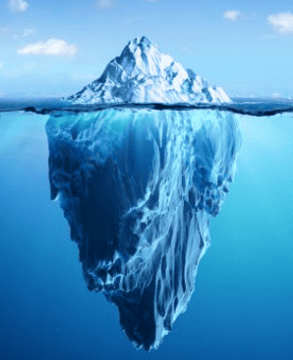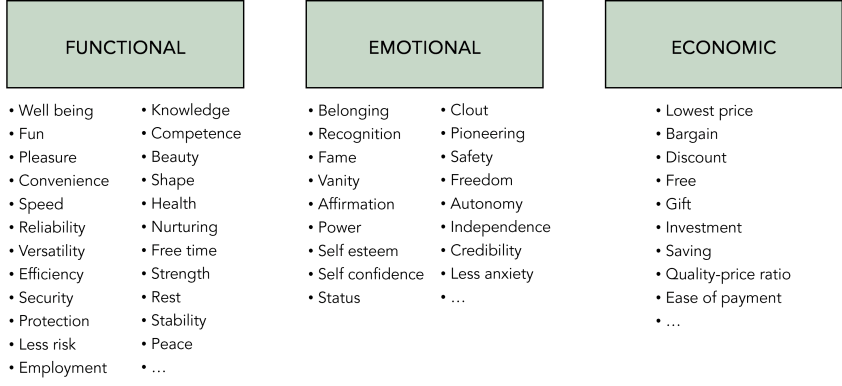The reasons why people buy

Do you know the reasons why people buy? Do your marketing and sales teams know? It is easy to see that if they understand client motivations, it will be easier and more effective to sell your products and services and, consequently, to make your company grow.
To do this, they need to be intelligent!
Intelligence comes from the latin "intus legere", which means to read the inside, i.e. to understand people's motivations. To achieve this, you need to ask the question "what are the client's decision criteria?". The answers can vary and differ depending on whether you are talking about an individual (B2C = business to consumer) or an organization (B2B = business to business), but they have a common basis, as we will see ahead.
The difference between B2B and B2C
When a sales channel is B2C, the company sells directly to the consumer, or end client, through different means of sale:
- Stores (also called shops, agencies or stands): they can be physical, virtual or mobile. The contact initiative lies with the consumer.
- Contact centers: they can interact by telephone or by post. Both the consumer or the company can initiate contact.
- Door-to-door: the company's salespeople go to consumers' homes.
- Personalized: the type of product or service offered by the company is high-priced (e.g. house, car, swimming pool, sailboat) and involves the formal acceptance of a written proposal given to the consumer before taking the decision to buy. The company has a sales team to talk to the consumer during the buying process, which usually involves more than one contact.
In the first three cases above, the purchasing decision is almost always made by the consumer alone. In the last case, the consumer's family is often also involved in the buying process, which requires an additional effort on the part of salespeople to understand the motivations of the different people in the family.
This last case is similar to B2B sales, which usually also have several people involved.
When a sales channel is B2B, the company sells directly to a client organization, which can use the offer in four different ways:
- B2B4A (application): the client buys the offer to apply it to their own business processes, for example industrial equipment for a production line or insurance against fire.
- B2B4T (transformation): the client buys the offer to transform it, incorporating it into their own offer for their clients, for example milk to produce yogurt or steel to produce window frames.
- B2B4I (intermediation): the client is an intermediary (agent, broker, consultant, integrator, auctioneer, virtual marketplace) who does not buy the offer, but only intermediates the sale to their own clients (consumers or organizations), receiving a commission for the service provided to the company.
- B2B4R (resale): the client (distributor, wholesaler, retailer, dealer, franchise) buys the offer to resell it to their clients, who may be consumers or organizations.
The first two cases above are also known (indistinctly) as B2B, although they require different sales approaches. In the first case, the sale is concluded in one transaction, in the second case the sale begins with the conclusion of a supply contract and the following moments correspond to orders placed under that contract.
The last two cases above are also known (indistinctly) as B2B2C or B2B2B, although they also require completely different sales approaches. In the first case, the company controls the selling price presented by the intermediary (or intermediate client) to the end client, in the second case it is the client who controls the resale price.
It should be noted that the acronyms B2B and B2C apply to sales channels, not companies. Any company can have both B2B and B2C sales channels.
People's motivations
Having made the distinction between B2C and B2B, let's start by asking the question "what are the client's decision criteria in B2C sales channels?".
Of course, it depends a lot on the offer.
If it is food, the decision criteria may involve taste, nutrients, the lowest or highest price, the best relationship between quality and price, the convenience of the packaging, trust in the brand, or many others.
If it is a car, the decision criteria may involve aesthetics, engine power, acceleration, top speed, pollutant emissions, size, interior space, trunk space, lowest or highest price, best price-quality ratio, brand fame, or many others.
The decision criteria are very different depending on the offer and the client's needs and preferences, but they necessarily fall into the three categories functional, emotional and economic:

The figure above shows some examples of the motivations people may have for buying a product or service. There are often several motivations involved, i.e. people don't decide on the basis of just one criterion.
Before you read the next paragraph, think for a minute about what you would do if you won 100 million euros in the EuroMillions.
When a person is asked this question, the answer usually includes buying something (e.g. a house, car, clothes), traveling, investing, setting up a business, partying with friends, donating some of the money to family and friends, contributing to altruistic projects, setting up a charitable foundation, among other initiatives.
This shows that people have three spheres of motivation:

The self sphere is usually the strongest, but the close and distant spheres are also relevant to decision making. For example, nowadays it is very common to see brands boasting about the environmental sustainability of their products.
As sales teams contact clients, they accumulate knowledge about their motivations, which they must share with each other and with other areas of the company, especially the marketing team. In turn, this team must continually deepen its understanding of client motivations, for example through focus group studies and collecting opinions in stores, on websites, on social media and on client service hotlines. Naturally, the marketing team should also share the knowledge acquired with the sales teams.
These practices apply to both B2C and B2B.
It is time to ask the question "what are the client's decision criteria in B2B sales channels?
Of course, it depends a lot on the offer.
But it also depends on how the client uses the offer (B2B4A, B2B4T, B2B4I, B2B4R) and the role of each person involved in the purchasing process. In fact, in B2B there is a very important nuance, it is the organization that buys, but it is a group of people who decide to buy. These people act simultaneously as representatives of the organization and as individuals, which means they have both corporate and personal motivations.
Four types of buyer in B2B sales channels
Corporate motivations depend on the person's role in the buying process, which can be final, user, technical or guide:

The final buyer is the one who makes the final purchasing decision. There is only one in each purchasing process, they have autonomy to decide on the use of the money, they have veto power and their focus is on the return on investment and the impact on the organization. They can be leaders of the organization, belonging to the board of directors or in charge of a department, but they can also be junior technicians if the purchase is small and of little strategic importance to the business, as can be seen in the figure below, which illustrates where the final buyer is usually located:

User buyers assess the impact of the purchase on their work. There may be several in each purchasing process, they use or supervise the use of the offer and their focus is on the impact on their responsibilities. They usually belong to a functional department in the organization, for example marketing, sales, research, production, logistics or finance, but they can also belong to the board of directors.
Technical buyers filter out valid purchase alternatives. There may be several in each purchasing process, they assess quantitative aspects and requirements to be met by the offers, they often act as access blockers for the other buyers, they have veto power and their focus is on pre-selecting viable offers. They usually belong to a technical department of the organization, for example information systems, purchasing, legal or risk management, but they can also belong to the board of directors.
Buyer guides give us guidance to win the sale. There may be several in each buying process (it is important to have at least one), they give us useful information about the needs and preferences of the other buyers and their focus is to help us win the sale. They can belong to the buying organization, our company or neither.
A person can have more than one role in each buying process, for example, if the final buyer is simultaneously a guide buyer for our company, we are likely in a good position to win the sale.
Corporate motivations in B2B sales channels
In view of the above, the answers to the question "what are the client's decision criteria in B2B sales channels?" fall into the different buyer roles:

The figure above illustrates just a few examples of the motivations of each type of buyer. It would be futile to try to list them all, but it is up to the marketing and sales teams to continually improve their knowledge in this area, which also varies according to the segment each client fits into.
It is worth noting that guide buyers do not have corporate motivations. This is because they don't need to be part of the client's purchasing team, but they have access to the people in that team. Naturally, if a guide buyer is also one of the other types of buyer, he will have the corporate motivations of that type of buyer.
Three stories
In 1999, I led a team of consultants that carried out an e-business strategy project for a national car importer and distributor. One of the recommendations was the implementation of a CRM information system shared with the brand's dealers, preparing the company for a diversification of the brands sold and served by the dealers, due to legislation that would come into force three years later. The recommendation was well received and we presented a commercial proposal to implement the CRM system. Almost all the buyers (finance, marketing, sales, after-sales, IT, legal) agreed with the proposal, but the CEO did not. When I spoke to him, he admitted that the project was worthwhile, but he still had doubts about its success. At the time, I couldn't figure out his motivations and the project didn't go ahead. Two years later, I learned that the CEO was ill at the time we spoke and had only a year to go before retiring, he simply didn't want to go through the disruption he thought would cause to the company and the dealers.
In 2009, following a number of successful projects for a directorate-general of the Portuguese state, my team submitted a commercial proposal for the implementation of a budget analysis information system. The report from the tender analysis committee put us in first place, but there was a complaint from a competitor. The committee re-analyzed the proposals and put that competitor in first place, with incomprehensible arguments. A few years later, I learned that the director of information technology at the directorate-general, who was part of the analysis committee, influenced the results because he had a son employed by the winning bidder.
In 2022, after a successful sales training for a project design and development company, I presented a new commercial proposal for another training. The managing director and the finance director agreed with the proposal, but the human resources director was hesitant to decide. When I spoke to him, I realized that, contrary to what he initially told me, he wanted to deliver part of the training. I changed the proposal to deliver the training together, which was approved almost immediately.
Personal motivations in B2B sales channels
These stories illustrate that buyers don't decide exclusively on the basis of corporate motivations; their personal motivations are also relevant and sometimes decisive. The problem is being able to identify them, because, like an iceberg, they are below the surface of the water.

As shown in the figure above, corporate motivations are discussed openly, above water, and are related to price and value for the buying organization, from the perspectives of the different types of buyer (final, user, technical). Personal motivations are not discussed openly and, unsurprisingly, as in B2C, they also necessarily fall into the three categories functional, emotional and economic:

The figure above illustrates just a few examples of the personal motivations of buyers in organizations, regardless of the buyer role they assume in each purchasing process, i.e. they are valid for final, user, technical and guide buyers. It is the responsibility of salespeople to understand the context of each client, i.e. their needs and preferences, to maximize the likelihood of selling.
Conclusion
To be successful in sales, you need to understand (read inside) what motivates clients to buy.
In B2C sales channels, you need to understand clients' personal motivations from a functional, emotional and economic perspective.
In B2B sales channels, as well as understanding the corporate motivations of final, user and technical buyers, you also need to understand their personal motivations, from the same three perspectives as in B2C, without forgetting the very special guide buyer.
Now that you know the reasons why people buy, both in B2C and B2B, develop the skills of your marketing and sales teams to boost your company's growth.
Filipe Simões de Almeida
Managing Partner, FI Consulting
Published on 14-Sep-2023
